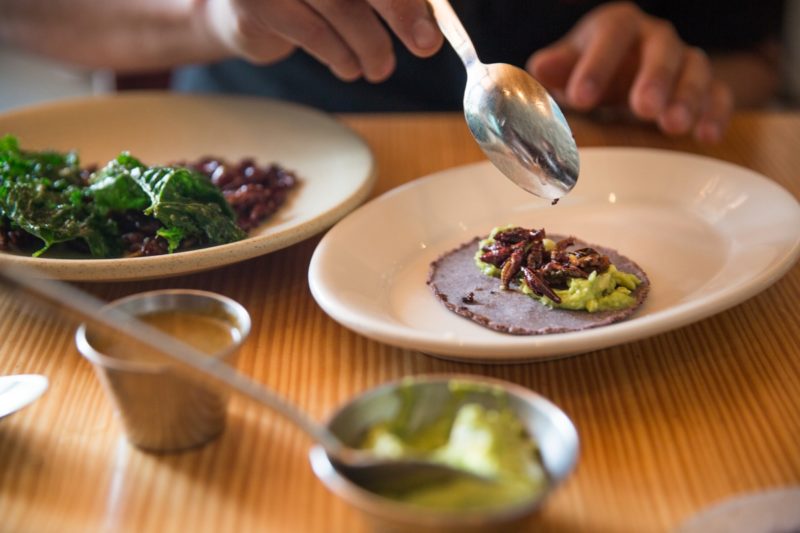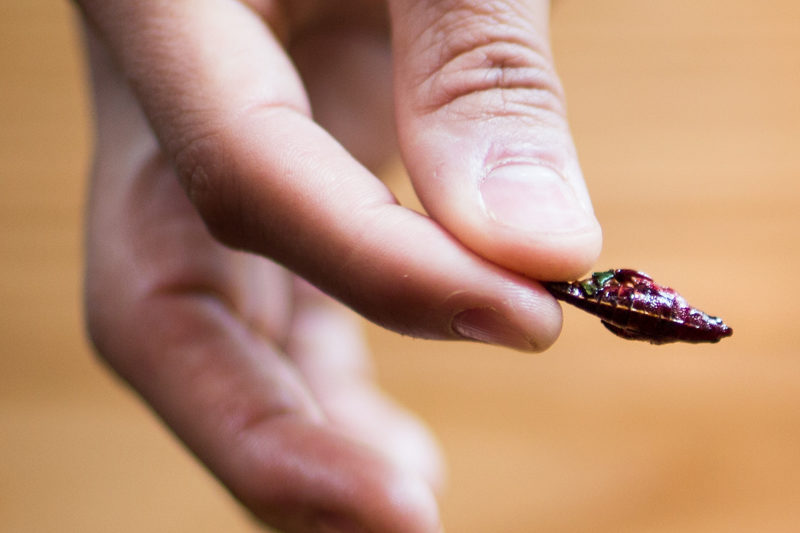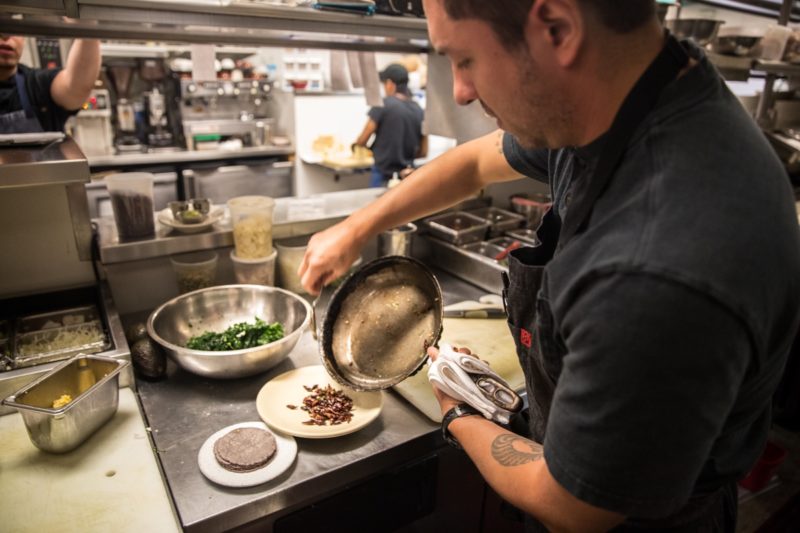Grasshopper, Cricket Enthusiasts Seeking Adventurous Palates
By Shelby Knowles
Reporting Texas

Chapulines, a traditional Mexican grasshopper dish, is served as an off-the-menu item at Austin’s upscale restaurant, La Condesa. Shelby Knowles/Reporting Texas
Behind La Condesa’s heavy wooden doors and underneath colorful murals, the downtown Austin customers sipped top-shelf margaritas as they awaited their off-the-menu, unconventional dish.
Eventually, the $10 appetizer arrived with salsas, blue-corn tortillas, guacamole and the kale-veiled main event: grasshoppers.
The traditional Mexican dish with a light papery crunch, known as chapulines, has been served at the Second Street District’s restaurant for three years now but without much fanfare. And while grasshoppers aren’t exactly jumping off the menu, other area eateries are hoping to change that.
Popularizing edible insects in American culture is no easy feat, and aficionados pushing for more sustainable food options want to help others make this transition. Eating insects, known as entomophagy, offers high nutritional value, long-term sustainability and a low carbon footprint, proponents say.
At La Condesa, the hoppers’ exclusivity has created some buzz. Still, they will remain an off-the menu-item until edible insects become more mainstream, executive chef Rick Lopez said. He wants to preserve the authenticity of the traditional dish, which is especially popular in the Mexican state of Oaxaca, and keep chapulines from becoming a gimmick or dare.
“Austin loves the long lines for barbecue, the cool after-parties and the VIP treatment,” he said. “That’s the idea.”

More than 2 billion people worldwide eat insects such as grasshoppers. Shelby Knowles/Reporting Texas
Enthusiasts such as Robert Nathan Allen, founder of Little Herds, an educational nonprofit based in Austin, aims to inform the public of the benefits.
“It goes along with the generational shift of what’s important in our broader food conversation,” Allen said. “Responsibility, transparency, traceability, humane treatment of animals… all of these different aspects of the broader food movement align perfectly with edible insects.”
In 2012, Allen saw a video about entomophagy and was immediately interested in the concept. He called scientists looking for more information about the benefits of insects. As his fascination blossomed, Allen decided to share the concept and eventually found a specific and enthusiastic audience.
“We saw that children didn’t have the psychological taboo built up like adults did,” Allen said. “They were much more open to trying new things, and it was a great opportunity for us to educate the parents.”
Convincing adults, though, remains another feat for edible insect product suppliers, a hurdle Aketta, an Austin-based company, hopes to overcome. The farm raises and sells products such as whole roasted crickets and cricket flour. Crickets and grasshoppers are close cousins, both members of the same biological order.
Aketta was formed after the parent corporation, Aspire, won a $1 million prize to the start-up enterprise with the most innovative idea for that year’s given topic. Responding to the challenge of addressing the theme of a global food crisis, Aspire showcased how edible insects improve access to affordable nutrition and increase sustainability worldwide.
“Our goal is to make these crickets and the protein powder that comes from the crickets affordable enough where the world can be fed and really solve food insecurity and sustainability issues,” said Vincent Vitale, Aketta’s business development manager.
Aspire moved from Canada to Austin because of the warmer weather, lower operating costs and open-minded food culture. According to Aketta, insects provide nutritional and environmental benefits that far surpass the cattle industry. Crickets have more protein, calcium and iron, while requiring less land, water and feed than their four-legged counterparts. Thirty grams of crickets produce 1,815 times less carbon dioxide emissions than the same amount of beef production.
“We have a unique advantage in the sense that the product we are working with is so rich in nutrients, [but] the disadvantage of it happens to be [that it’s] an insect,” said Vitale.
Pushing forward, Aketta will be partnering for a South by Southwest event next month in hopes of spreading the word about their brand. Locally, Aketta continues to work with chocolatiers, bakeries and restaurants on how to incorporate crickets into their menus through cricket-based muffins, chocolate-covered crickets or deconstructed cricket tacos.

Rick Lopez, La Condesa’s executive chef, is keeping grasshoppers off the menu until they aren’t considered a gimmick. Shelby Knowles/Reporting Texas
“You can expect a much bigger local push for our product this year,” Vitale said.
Cultures around the world have consumed insects for millennia—caterpillars in Africa, grasshoppers and ants in Mexico, locust in Thailand. More than 2 billion people in over 80 percent of the countries around the globe consume insects, according to the United Nations Food and Agricultural Organization. Most Americans, however, have not yet fully embraced edible insects.
But American food culture has expanded before, and edible insect activists like Robert Nathan Allen are hoping it will again. After all, raw fish wasn’t always the fashionable food that it now is, Allen pointed out.
“When we looked at other examples of Western food trends changing, most recently sushi is a great example of how something goes from ‘dangerous’ and ‘disgusting,’” Allen said. “But with a generational shift, [it] goes to being completely normal.”